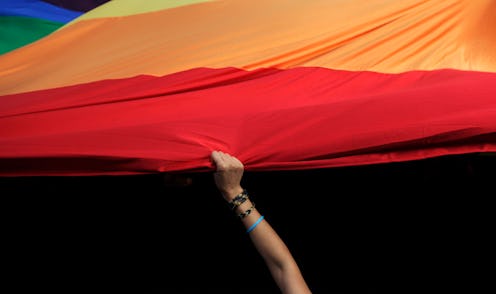Life
9 Little Ways To Be More LBGTQ Inclusive
It's hard to overstate the effect little ways to be more LGBTQ inclusive can have on someone's day. They might not elicit the kind of celebrations that, say, the legalization of same-sex marriage did back in 2015, but that's probably for the best — I'm not certain the human heart could stand that much excitement for very long. When it comes to LGBTQ rights, it's natural to focus on the big picture: Legislative wins and losses, media representation, cultural attitudes, and so on. However, everyday gestures are equally important, because they add up over time to create a safer, more accepting environment for LGBTQ people.
You don't have to be out in the streets canvassing for votes or lecturing on gender identity all day, every day, to support the LGBTQ community. For one thing, most of us have jobs, social lives, and cat videos demanding our attention, and for another, you have to pick your battles, or else you'll just end up exhausted. If you have time to do the big picture stuff, great! But if you're looking to be more LGBTQ inclusive, there are plenty of small ways to be more welcoming — even just knowing that someone is trying always helps. With that in mind, here are nine little ways to be more LGBTQ inclusive in your everyday life, according to someone from the community.
1. Learn The Basic Acronym
The current full version of the acronym, LGBTQQIP2SAA, is admittedly intimidating (and it's often evolving, as well), but definitely familiarize yourself with the basics beyond just homosexuality: Bisexuality is a thing, asexual people don't experience sexual attraction, and so on. You can watch Bustle's guide to the acronym here.
2. Don't Use "Gay" As A Slur
It's fairly common practice now, but if you haven't done it yet, stop using "gay" as a slur. It implies that there's something inherently wrong with being LGBTQ, and besides, it's so 2006.
3. Pay Attention To Pronouns
If someone uses pronouns you didn't expect, don't make a big deal about it — just follow their lead. That doesn't mean you can't ask about it, obviously, but don't interrupt conversation on another subject to make a big deal about them dating a woman or being transgender.
4. Don't Call Someone's Dating History A "Phase"
And we're back at bisexuality again. Although people do experiment with their sexuality, don't assume someone went through a lesbian or gay phase just because they're now dating someone of the opposite gender, or vice versa. If you must, tattoo the phrase "bisexuality exists" onto the backs of your eyelids before you go minimizing someone else's sexual history. But even if they now identify as a different sexuality than they did previously, remember that sexuality is fluid — their current identity doesn't negate their past choices.
5. Let People Have Their Privacy
Transgender people are often subject to invasive questions about their bodies (and yes, something can be invasive even if it's well-meaning). Aside from being invasions of privacy, this serves to ultimately draw attention away from more important matters. "By focusing on bodies, we don’t focus on the lived realities of [transgender] oppression and... discrimination," actress and part-time goddess Laverne Cox explained to Katie Couric in 2014.
6. Ask Questions
Don't pry into someone's personal matters, especially if they're clearly uncomfortable, but if you're worried about misgendering someone or unclear on someone's sexual identity, it doesn't hurt to ask as long as you're respectful about it. (Just know when to back off.)
7. Know The Difference Between Gender Identity & Sexuality
Gender identity is, well, the gender with which you identify, whether or not it's the one you were assigned at birth. Sexuality is who you're attracted to; straight people can be transgender, and transgender people can be gay (or bi, or anything else). Although they're grouped into the same LGBTQ category, gender identity and sexuality ultimately deal with different matters — they're not the same thing, nor are they interchangeable.
8. Don't Tokenize People
It's a benevolent form of stereotyping, but that doesn't change the fact that tokenization is still stereotyping. One particularly widespread example is that of the gay best friend. As Lauren Duca wrote for the Huffington Post, "It’s not fair to push your preconceived notions on someone who maybe doesn’t want to listen to your problems or spend the day at the mall just because he is gay." Basically, don't define someone by their sexuality or gender identity — if that's the first thing that comes to mind when you think of them, it's time to reevaluate your friendship. (The same goes for any minority, not just people who are LGBTQ.)
9. Don't Make Assumptions
You don't have to tiptoe around everyone you meet, but try to rein in your assumptions about people's gender identity and sexuality. Having short hair and a love of flannel doesn't make you a lesbian, and being a particularly masculine man doesn't make you straight. Basically, keep an open mind and you'll be fine.
Images: Giphy (9)
